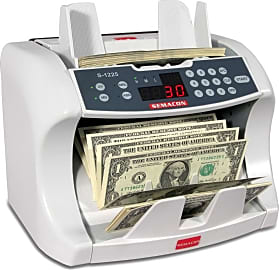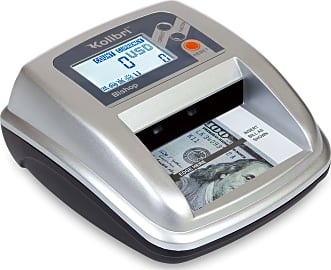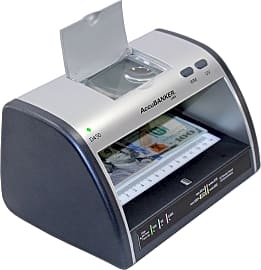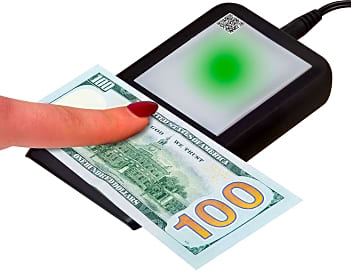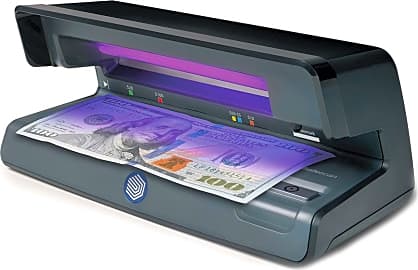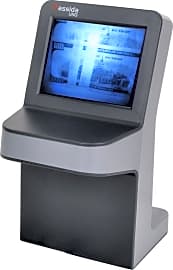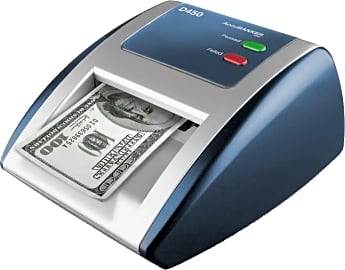The 10 Best Counterfeit Bill Detectors

This wiki has been updated 34 times since it was first published in September of 2016. Run your bank or retail store with maximum confidence and minimal risk to your profits with one of these handy counterfeit bill detectors. Whether through infrared, magnetic, or ultraviolet sensor technology, they can ensure the paper currency you receive is the real McCoy. We've included models suitable for high-volume businesses, as well as some more affordable options for smaller operations. When users buy our independently chosen editorial selections, we may earn commissions to help fund the Wiki.
Editor's Notes
December 24, 2020:
It was a fairly painless round of updates, as all of our previous picks for the category continued to be great choices today, which left us with no need to make many changes.
We did, however, decide to replace the GStar Elite with the GStar Supreme. On top of all the same great features offered by the Elite, the Supereme also applies two additional detection methods: dimensional verification and metal-thread checking. The Supreme is a few pounds heavier than the Elite, but we didn’t see that as much of a deterrent, as the machine’s likely to be permanently situated. And at 17 pounds, it’s still light enough to be put away by most.
We also considered upgrading the Kolibri Bishop to the company’s premium model – the Kolibri KCD-2000, which features a superior display, and applies a fourth detection method by measuring bill size – but decided against making the switch since the model seems to be suffering from some availability issues, presently.
April 05, 2019:
Depending on the type of business one runs — from small vendors with limited staff to large operations selling high-price items — a variety of features in a counterfeit bill detector may be in order. Professionals who operate out of kiosks, sell their product at constantly relocating festivals, or even visit customers' homes to make sales will appreciate the Dri Mark Flash Test. It's about the size of a smartphone and can be used with just one hand, making it easy to take it and plug it in just about anywhere and swiftly check bills. The Bsure Pocket Size is another excellent choice for small business owners who might visit several locations in order to make sales. Criminals may not expect someone who runs a small and mobile operation to catch onto them, so they'll be surprised to see you take out this efficient little gadget. As for larger-scale operations that turn over a high profit and take in a lot of cash, the Semacon S-1225 is in order. It can review an impressive number of bills per minute and is built to withstand years of heavy use. The G-Star Elite is another great pick for busy businesses, as it can check over 1,000 notes per minute, and can run for up to six continuous hours without slowing down. If several types of fraud have occurred at your business, you may appreciate the AccuBanker USA LED430 and the Sacescan 50, both of which check for counterfeit forms of IDS like passports and driver's licenses, in addition to fake cash.
A Brief History Of Counterfeit Currency
Upham originally started making fake cash as a political statement, but like many politicians, he found that the money was more alluring than the message.
Counterfeiting money has been around for so long, many people call it "the world's second-oldest profession" — with the oldest, of course, being professional ghost hunter.
The first coins popped up in the Greek city of Lydia sometime around 600 B.C.E. These were made of gold or silver, and criminals would mix those metals with their baser counterparts. They'd also trim the edges of coins and use the shavings to make new coins.
The rise of paper money didn't stop counterfeiters, either. In China in the 13th century C.E., currency was made from mulberry wood; this prompted the Chinese government to post armed guards around mulberry forests, so that evildoers couldn't come in and chop down their own personal money trees.
The crime was seen as so serious in the Middle Ages that it was often punishable by death. An English couple, Thomas and Anne Rogers, was convicted of clipping forty pieces of silver; he was drawn, quartered, and hanged, while she was burned alive. Suffice to say, they never did it again.
This philosophy carried over to colonial America, as most early currency had the words "to counterfeit is death" printed on it. That didn't stop criminals, of course, and one man, Samuel Upham, may have been the most successful counterfeiter of all time. Upham originally started making fake cash as a political statement, but like many politicians, he found that the money was more alluring than the message. Upham claimed to have made and distributed millions in fake money over his career, enough that he could have single-handedly made the Louisiana Purchase if he'd been so inclined.
Men like Upham were so successful that Abraham Lincoln was forced to create the Secret Service to investigate counterfeiting crimes (ironically, their other job is protecting presidents). Counterfeiting was out of control after the Civil War, with some estimating that a full third of all currency in circulation at the time was phony.
While the Secret Service was largely successful at busting up fake money rings, the primary weapon against counterfeiters would prove to be the bills themselves. Advancements in printing technology, as well as the use of a highly specific paper made of cotton, have made it harder than ever to make passable bills.
That hasn't stopped the bad guys, though. Hundreds of people attempt to fool the feds every year. As far as crimes go, though, there's certainly lower-hanging fruit out there.
How To Spot A Fake Bill
If you suspect someone might be trying to slip you some funny money, then you should obviously invest in a detector. There are other things you can look for that can tip you off to the fake stuff, however.
It should glow in a different color if you put it under UV light.
Before we get started, though, we should warn you that the detecting machines are more effective than the pens, so don't try to take the cheap way out. That being said, the first place you should always check is the watermark. Hold the bill up to the light, and there should be a faint image to the right of the portrait.
While you're holding it up, look for the security thread (this won't work on anything smaller than a five). It's a small strip running down the face of the bill, and it's on a different location for every denomination. It should glow in a different color if you put it under UV light.
You can also bust out a magnifying glass and look for the small, micro-printed words that are in various places on the bill. They say things like, "USA" or "E pluribus unum," so if you see one that says, "I'm with stupid" or anything similar, you've probably got a forgery on your hands.
The way the paper feels is another tell. It should be slightly rough — a consequence of using cotton, rather than normal paper.
Basically, trust your gut. If the money seems off, check it before you accept it.
Things You Didn't Know You Wanted To Know About Counterfeiting
Running across counterfeit currency seems like one of those things that you hear about, but never expect to actually encounter.
However, chances are you've had some in your hand at some point in your life, and there's a decent chance there's a fake bill in your wallet right now (I figured out a foolproof way to beat the crooks, though — I don't have any money).
Although paying the fines shouldn't be that difficult, if you're a good enough counterfeiter.
The first thing you should realize is that you can get funny money from anywhere, even banks, so don't think merely avoiding seedy characters will do the trick. Check your cash before you walk out of the building, though, because once you leave with that fake bill, the bank won't take it back.
As you might expect, the most-spoofed bills are the higher denominations. However, people still forge coins, although they're usually not as good at it (and the ridges on some coins are actually there to prevent counterfeiting). Mostly, though, fake coins are made to fool collectors, rather than laundromats.
You're most likely to encounter bogus cash while traveling. This is because you're less likely to recognize fake bills in a currency you're unfamiliar with, and bad guys see tourists as easy targets.
Oh, and in case you were tempted to start printing up your own imitation riches, you should know that being convicted of counterfeiting in the U.S. can land you behind bars for 25 years, as well as cost you some massive fines.
Although paying the fines shouldn't be that difficult, if you're a good enough counterfeiter.


